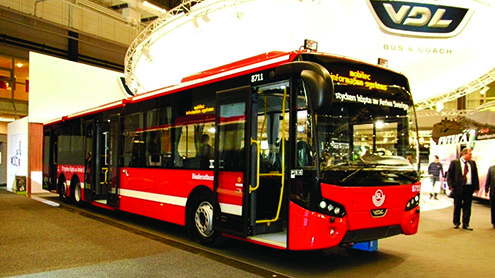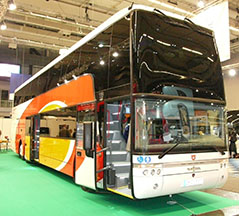
 the international report
the international report
By Doug Jack
The Nordic public transport exhibition Persontrafik attracts exhibitors and visitors from Denmark, Finland, Norway and Sweden. The exhibition held in Sweden alternates every two years between Gothenburg on the west coast and Stockholm on the east coast. These countries follow European regulations on the construction and operation of buses and coaches.
Many city and suburban bus services contract with a mix of Nordic operators and other European companies, usually for a fixed term of up to seven years. Most require new vehicles, making the average age of the fleets very young. Many buses sold at midlife find their way across the Baltic and further east.
All four countries are highly sensitive environments. Sweden is particularly sensitive because there is strong political pressure to run buses that use alternative fuels, especially compressed natural gas and biogas.
Although gas is less expensive than diesel and the price of a gas-fueled bus depreciates to practically zero over the life of a seven-year contract, there is almost no market for used gas buses. The contract price per mile must be higher than with a standard diesel bus — a price that Swedish politicians are willing to pay, though the residual value is decent.

In Stockholm, around 700 Scania buses run on ethanol with cleaner exhaust emissions than even the latest diesel engines. Produced in Sweden from the sap of pine trees, the fuel is therefore a by-product of the extensive forestry industry.
There is more space in most of the Nordic towns compared with other parts of Europe, therefore many city and suburban buses are at maximum legal length of just over 49 feet on three axles. Most feature a low-entry layout with two internal steps to seats above and behind the rear axles. This gives higher seating capacity but still provides accessibility for passengers in wheelchairs or with baby strollers in the front half of the vehicle. There are some articulated buses, but they are not so popular because of perceived traction problems in winter weather.
A congestion-charging zone to deter motorists from driving into the city centers has been in place in central Stockholm for a couple of years. Gothenburg is about to introduce a similar system. Some bus companies have been encouraged to invest in double deck coaches, which provide regular commuter services from nearby towns.
In Sweden, a double deck bus can be built to an overall height equivalent to 13 feet, 8 inches and a width of 8 feet, 6 inches. Scania and Van Hool have largely, but not totally, cornered the market. They have also built some models, which have a large freight compartment towards the rear of the lower deck, for use on long trunk services to the sparsely populated north of the country.

As the rail networks in both Norway and Sweden are relatively limited, coaches are in use on regular express services. Many of them can run up to 250,000 miles per year. Because of the long distances, maintenance standards are extremely high. Authorities in the main cities restrict entry to Euro 4 or Euro 5 vehicles, while older coaches can run in the more rural areas.
Volvo has tried hard to promote hybrid buses with greater success in Norway than Sweden. Its home city of Gothenburg has 25 in service and will shortly take a further three that will be the first with plug-in technology. They will receive a fast charge of electricity at each terminus. Volvo expects that the vehicles will be able to operate up to 70 percent of the route in all-electric mode. A further 25 hybrids are on order for a contractor in the Gothenburg region.
While Volvo has been very successful with its hybrid buses in other parts of Europe, it looks as if efforts in Sweden might at last be bearing fruit. There was talk at Persontrafik of up to 400 hybrid buses being required over the next two or three years in Sweden. Scania, the other major Swedish manufacturer, has not yet shown its hand on hybrid buses apart from a very small number of prototypes.
Volvo has announced plans to close its bodybuilding plant in Säffle, a town to the north of Gothenburg. It was the last remaining factory capable of building city and suburban bodywork in Sweden. Volvo will continue production in the more modern factory in Wroclaw, Poland, where labor rates are much lower. The last bodybuilders in Denmark and Norway had already gone but are still active in Finland.
The most advanced vehicle in the exhibition was one of five hybrid hydrogen fuel cell buses borrowed by Van Hool from its customer, Ruter A/S of Oslo, Norway. These 42 foot, 8 inch tri-axle buses use hydrogen produced by electrolysis of water. The electricity required for this process comes from a hydroelectric power station; therefore the buses are almost entirely CO2 free.
Van Hool also secured an order from the southern Swedish city of Malmö for 15 bi-articulated versions of its new ExquiCity vehicle, which looks more like a tram than a bus. CNG engines will provide thermal power for the fleet due to go into service in 2014.
Optare brought two of its 30-foot Solo midibuses from the United Kingdom. While one was quite conventional, the other was perhaps the first mid-sized hybrid bus ever displayed in Sweden. It has a small Mercedes-Benz engine and a Siemens hybrid drive system with electrical energy stored in super capacitors, mounted at roof level. Unusual for such a short vehicle, this one had two double-width doors, heavy-duty heating and double-glazing.
The challenge for Optare and its importer is to change the mindset of the great majority of Nordic operators. Midibuses have lower capital costs and lower running costs although drivers still expect much the same wage as for a full size bus.
On the other hand, if they run more frequently on a route, then they might well provide a higher standard of service and attract more custom. It must be a feasible proposition in cities that charge motorists a fee for using their cars.

At one time, Scania and Volvo largely shared the Swedish city and suburban bus market. As demand has increased in the market, particularly for gas-fueled vehicles, MAN and Solaris of Poland have both come in with their well-established models.
Solaris has been able to develop and supply buses with a combination of features that the larger manufacturers simply do not offer. Similarly, VDL from the Netherlands has been able to make headway with its city buses, which use more composite materials than its competitors. They are not only light in weight but also totally resistant to corrosion. BR
Doug Jack is with Transport Resources in the United Kingdom.

Scandinavians sure do like their public transportation!